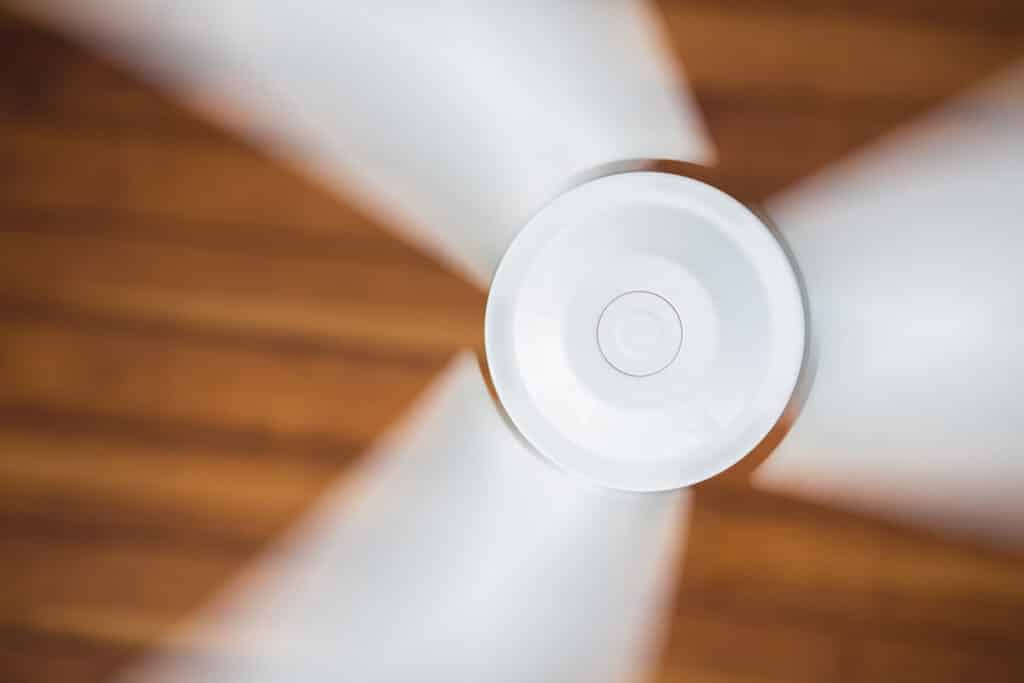Breaking down the pros and cons of climate control.
So you’ve stood in front of the open fridge, put your clothes in the freezer, slapped a wet flannel on your head and taken a cold shower. You’re sleeping naked with a pedestal fan blowing a meagre puff of wind over your face, sheet discarded because the thin layer of cotton is too hot to handle.
It’s time to invest in climate control, and now you’ve got to choose between air conditioning or ceiling fans.
Both, of course, have their merits – but which is more suitable for you? That all depends on whether you favour a lower upfront cost, a lower environmental impact, better electricity savings or a seriously ice-cold home.
Read on to find out the pros and cons of ceiling fans and air conditioners across these categories. But don’t worry – either option will free you from the open-freezer method.
When it comes to… UP-FRONT UNIT COST
The winner: ceiling fans.
Why: Of course, you will need more than one fan unless you want the whole family to huddle under it. The total cost depends on the number of rooms you want a fan in. Generally that includes all bedrooms, lounge rooms and recreational areas. In order to compare up-front unit cost, though, we need to look at the cost of installing a ceiling fan in just one room of a house.
An average-priced ceiling fan in one room will set you back about $150. A split-system air conditioner in one room, on the other hand, will set you back about $750. For the cost of one air conditioner in a central living area, you could install ceiling fans in four bedrooms and one lounge. If you were to opt for ducted air conditioning, the cost of the exterior unit alone would set you back around $3000.
You also need to consider installation costs. You could have the cheapest split system air conditioner installed for less than the cost of purchasing and installing fans for the whole house. Or you could invest in evaporative ducted air conditioning, which has a big upfront cost but a low annual running cost. It depends entirely on your current budget and the size of your home.
When it comes to… ENVIRONMENTAL IMPACTS
The winner: ceiling fans.
Why: As you can expect, the cost of running an air conditioner is significantly higher than the cost of running a fan. The higher cost comes from the higher amount of power the product uses. A ceiling fan can use up to 90% less energy per hour than a split system air conditioner. However, it also depends on the type of air conditioning. An evaporative ducted air conditioner will use far less energy than a split-system because it simply passes air over cooling pads.
As we all know, higher energy use means higher carbon emissions. A 2019 article from The Guardian predicts air conditioning will create about 2 billion tonnes of C02 per year in the near future. You can negate this by selecting modern, energy-efficient air conditioning appliances if you’re not willing to opt for a ceiling fan.
When it comes to… A BETTER SLEEP
The winner: split-system air conditioning.
Why: Air conditioning is the best option for a good sleep. It beats having a fan blowing in your face because it cools the whole room, and doesn’t need to be pointed directly at you. If you set your split-system air conditioner to a higher temperature (say, 23-25 degrees Celsius) it can be cost-efficient while still providing the comfort you need to be well-rested.
When it comes to… POWER BILLS
The winner: ceiling fans.
Why: It doesn’t take a genius to figure out that higher power use means higher power bills. Electricity costs continue to rise, and some estimates place climate control at around 40% of the total cost of household power bills over the course of a year. According to Canstar Blue:
- An average split-system air conditioner costs around 60c per hour to run.
- A portable air conditioner costs about 50c per hour.
- A ducted reverse-cycle air conditioner costs about $3 per hour to run.
- A ceiling fan costs about 3c per hour to run.
If you run any of these products when you arrive home from work (say at 6PM) and turn them off when you wake up the next morning (say at 6AM), that certainly adds up.
Why? To understand that, we need to know how split system air conditioners work. As cooled gas moves through the evaporator it absorbs heat from your home and carries it outside. It is actively cooling the air. With a ceiling fan, the motor is turning blades that simply shift the air around which creates a cooling sensation on your skin. The simpler the process, the lower the power bill.
Ceiling fans win again here.
When it comes to… SQUARE METERAGE
The winner: ducted air conditioning.
Why: If you aim to cool down as much of your home as possible, ducted air conditioners are the clear winner. With modern ducted systems you have the ability to zone rooms – everybody can have their room set to their desired temperature at bedtime, or you can switch off zones when not in use. This helps to manage some of the cost associated with ducted air conditioning. Ducted is by far the gold standard if all you want is to come home to a marvellously refreshing home in summer and have a seriously good nights’ sleep.
There are no clear winners here – it all depends on your priorities and your budget. But if you’re looking to have a split-system air conditioner installed in Perth or looking for the installation of a ceiling fan, you’re in luck. KNP Electrics & Air specialises in all varieties of air conditioning and fans.
We know how to install a ceiling fan and we know how to install a split system air conditioner. From Fremantle to Joondalup, we’re committed to prompt, friendly and reliable service. We turn up when we say we will, and we get the job right the first time.
Reach out today for a free ceiling fan or air conditioning quote – we can supply, install, service and repair them all.

